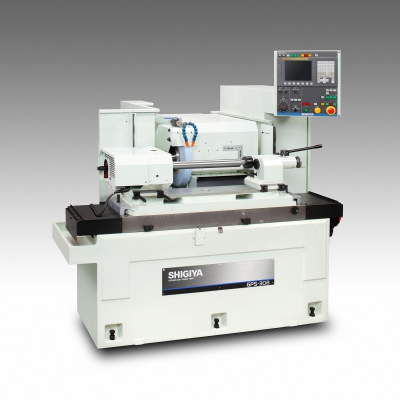
Shigiya (USA) Ltd. says its new GPS-30B CNC cylindrical grinder offers high-quality performance at an affordable price. A streamlined machine design, using common parts, and an efficient machine manufacturing process reduce costs and increase affordability.
The GPS-30B boasts a range of high-quality and rigid features to allow for heavy and precise grinding. Shigiya developed its own bearing grinder to grind the GPS-30B’s nonconcentric hydrodynamic bearings and ensure their rigidity and precision.
The GPS-30B wheelhead and table head sliding surfaces have wide V and flat slide way that provide sufficient rigidity and load capacity. The high dampening performance and equalization of the lubrication oil provided by the oil film’s squeezing effect help the grinder maintain precision and smooth operation for decades. To prevent thermal displacement due to an increase in lubrication temperature, the wheel spindle oil is stored in an isolated tank. Because the wheel dressing device is mounted onto the lower table of the GPS-30B, there is no need to change dressing coordinates. A nonswivel wheelhead with a highly rigid main body and large-diameter wheel spindle is available as an option.
For added convenience, Shigiya’s exclusive interactive conversational programming system requires virtually no programming knowledge to operate. The system automatically sets up optimal grinding patterns and conditions after an operator enters numeric figures for three items. The system accommodates a variety of grinding and dressing patterns to facilitate high-precision cylindrical grinding. Data for up to 47 workpieces can be stored with maximum steps. Tolerance input is possible at the submicron level. A variety of alarm functions are included to prevent human error.
The GPS-30B can change speed steplessly on the AC servomotor within a range of 15 to 600 rpm. Optimal rotational speed can be automatically determined by the interactive automatic programming system. To achieve high precision heavy grinding, the manual tailstock is mounted with a large diameter spindle that has been precisely processed.
The GPS-30 features a 300mm-dia. swing over table, maximum grinding diameter of 300mm and 500mm to 2,000mm distance between centers. Models with up to 750mm center-distance come equipped with a compact workhead and tailstock units.
Contact Details
Related Glossary Terms
- centers
centers
Cone-shaped pins that support a workpiece by one or two ends during machining. The centers fit into holes drilled in the workpiece ends. Centers that turn with the workpiece are called “live” centers; those that do not are called “dead” centers.
- computer numerical control ( CNC)
computer numerical control ( CNC)
Microprocessor-based controller dedicated to a machine tool that permits the creation or modification of parts. Programmed numerical control activates the machine’s servos and spindle drives and controls the various machining operations. See DNC, direct numerical control; NC, numerical control.
- conversational programming
conversational programming
Method for using plain English to produce G-code file without knowing G-code in order to program CNC machines.
- cylindrical grinding
cylindrical grinding
Grinding operation in which the workpiece is rotated around a fixed axis while the grinding wheel is fed into the outside surface in controlled relation to the axis of rotation. The workpiece is usually cylindrical, but it may be tapered or curvilinear in profile. See centerless grinding; grinding.
- dressing
dressing
Removal of undesirable materials from “loaded” grinding wheels using a single- or multi-point diamond or other tool. The process also exposes unused, sharp abrasive points. See loading; truing.
- flat ( screw flat)
flat ( screw flat)
Flat surface machined into the shank of a cutting tool for enhanced holding of the tool.
- grinding
grinding
Machining operation in which material is removed from the workpiece by a powered abrasive wheel, stone, belt, paste, sheet, compound, slurry, etc. Takes various forms: surface grinding (creates flat and/or squared surfaces); cylindrical grinding (for external cylindrical and tapered shapes, fillets, undercuts, etc.); centerless grinding; chamfering; thread and form grinding; tool and cutter grinding; offhand grinding; lapping and polishing (grinding with extremely fine grits to create ultrasmooth surfaces); honing; and disc grinding.
- tolerance
tolerance
Minimum and maximum amount a workpiece dimension is allowed to vary from a set standard and still be acceptable.






